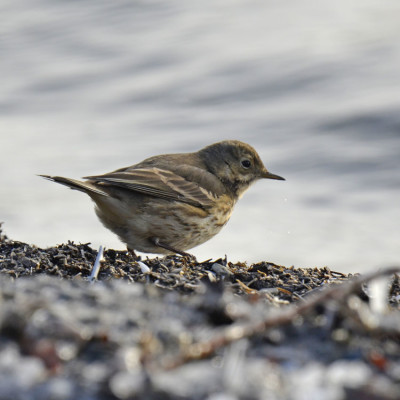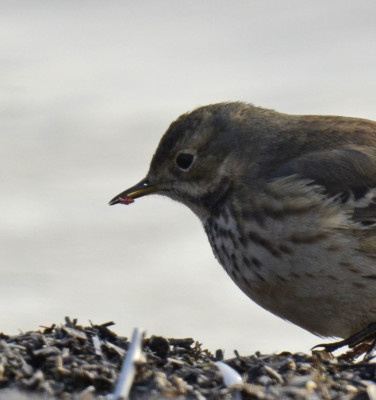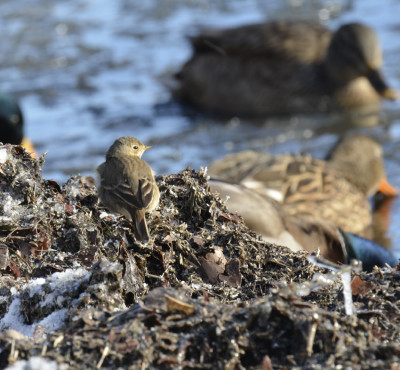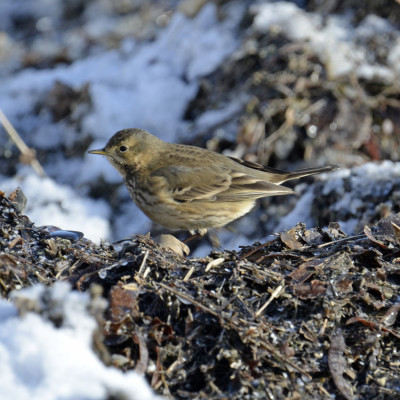I have never knowingly seen a Pipit although I watched a small sparrow-like bird on the rocks at Colonel Sam Smith Park in Toronto once that might have been one. I’ve always wanted to see one because I find the name very amusing. It reminds me of old British novels with unlikely characters saying things like “what-ho!” and “pip pip.” So when a report came in to the Hamilton Bird Studies group in January about an American Pipit struggling to survive on the shore of Lake Ontario in Mississauga, I went to see it.
Is a Pipit a Type of Sparrow?
I knew Pipits were small birds about the size of a sparrow or some warblers. I wasn’t sure, though, what type of bird it is.
I discovered first that it is a songbird. That wasn’t a big surprise as it doesn’t look much like a duck or a hawk!
Pipits and Wagtails belong to a family of birds called Motacillidae which does not include the sparrows or warblers.
The Sibley Guide to Bird Life & Behavior says that all pipits have “slender, pointed warbler-like bills.” That would definitely make them different from most sparrows.
Some pipits, like Wagtails, are noted for bobbing their tails while hunting. The American Pipit I watched bobbed its tail steadily while hunting among the wrack.
The other details that are used to divide birds into different families are a bit beyond my interest level, so I’ll leave this subject at this point!
What Was My American Pipit Doing?
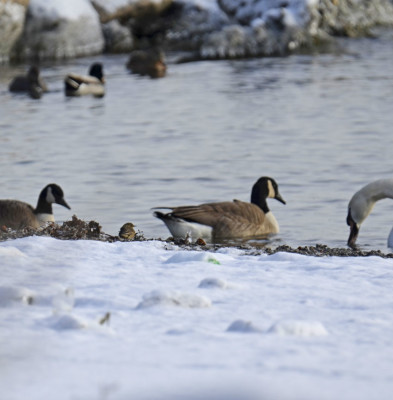
My Pipit wasn’t very large compared to the Canada Geese, Mute Swan and Mallards nearby.
I arrived near 9:30 in the morning. The American Pipit was perched on the frozen dead algae piled up at the edge of the lake, near a short jutting-out jumble of rocks that were making a small breakwater. The bird was very active: it would run briskly along the weeds, then stop and pick carefully among them. It moved steadily along the shore, keeping back from the splash-line, which seemed sensible since the small waves lapping on the rocks were forming icicles.
Over the next few minutes, the Pipit flew several times. It would jaunt out over the lake, in a rise and fall flight a bit like a woodpecker, but didn’t travel very far out before it turned back and returned to almost the same spot on shore. It was a bit as if it was looking for someone or thing. I don’t think it was testing whether it could fly over the lake, or I would have expected it to be steadily moving along the shoreline and testing at various spots.
The Pipit was much yellower on the underside than I had expected. It reminded me of a Waterthrush.
Once, a Canada Goose lunged at it! the Pipit took off and flew further along the shore. In a few minutes, though, it came back to the original area. By then the Goose had moved into the lake.
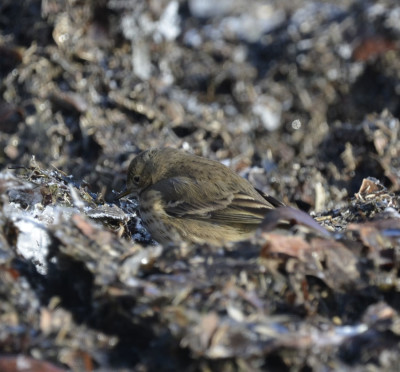
Its dark back blended well into the algae pile.
The Pipit’s tail end bobbed steadily as it hunted but not when it stopped to rest.
It was difficult to see what it was finding to eat among the algae and beach wrack. I did see it swallow something several times, although not as often as I would have liked. (I’m afraid if it doesn’t find more food more easily it may not survive.)
One time I saw it picking up something from the wrack that was red and was a cm or two long, and curled. It looked very like a thick-skinned worm. I’m not sure if that’s possible or not. The particular day I was watching, there were no snowflies out to breed, unfortunately for the Pipit.
Where Do Pipits Usually Hang Out?
Pipits are one of those world-wide birds. Our American Pipit used to be considered a sub-species of the Water Pipit but according to the Cornell University website, it is now considered a distinct species. Anyone who follows birds’ names for a few decades will realize that it could change again: birds which have very similar types are prone to getting re-classified.
American Pipits nest way, way, way up north, for the most part. Some, though, do nest in the mountain ranges along the west coast of North America. They migrate through all of Canada and generally winter in the US and further south. So here in southern Ontario, we’re most likely to see them during spring and fall migration.
Although the Pipit I saw was hunting for food along the lake edge, they are not limited to water habitats. They are often seen in farm fields, too. They eat insects and seeds which makes their lives a bit easier than some of the super-specialists.
I hope to see another American Pipit, or even a flock, some time as they migrate through my area. They are cheerful birds, reminding me of Semipalmated Plovers with their high-energy feeding behaviour and their frequent short flights.
Related Reading
Join In
Have you seen an American Pipit? Please share your sighting with a comment.


